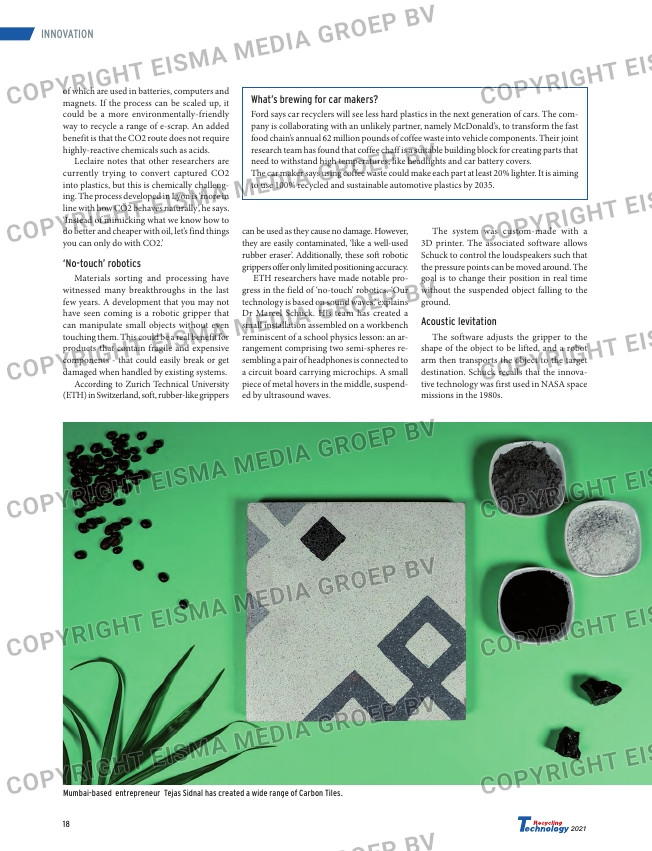Page 18 from: Out now: Recycling Technology 2021!

18
2021
INNOVATION
of which are used in batteries, computers and
magnets. If the process can be scaled up, it
could be a more environmentally-friendly
way to recycle a range of e-scrap. An added
benefit is that the CO2 route does not require
highly-reactive chemicals such as acids.
Leclaire notes that other researchers are
currently trying to convert captured CO2
into plastics, but this is chemically challeng-
ing. The process developed in Lyon is ‘more in
line with how CO2 behaves naturally’, he says.
‘Instead of mimicking what we know how to
do better and cheaper with oil, let’s find things
you can only do with CO2.’
‘No-touch’ robotics
Materials sorting and processing have
witnessed many breakthroughs in the last
few years. A development that you may not
have seen coming is a robotic gripper that
can manipulate small objects without even
touching them. This could be a real benefit for
products that contain fragile and expensive
components – that could easily break or get
damaged when handled by existing systems.
According to Zurich Technical University
(ETH) in Switzerland, soft, rubber-like grippers
can be used as they cause no damage. However,
they are easily contaminated, ‘like a well-used
rubber eraser’. Additionally, these soft robotic
grippers offer only limited positioning accuracy.
ETH researchers have made notable pro-
gress in the field of ‘no-touch’ robotics. ‘Our
technology is based on sound waves,’ explains
Dr Marcel Schuck. His team has created a
small installation assembled on a workbench
reminiscent of a school physics lesson: an ar-
rangement comprising two semi-spheres re-
sembling a pair of headphones is connected to
a circuit board carrying microchips. A small
piece of metal hovers in the middle, suspend-
ed by ultrasound waves.
The system was custom-made with a
3D printer. The associated software allows
Schuck to control the loudspeakers such that
the pressure points can be moved around. The
goal is to change their position in real time
without the suspended object falling to the
ground.
Acoustic levitation
The software adjusts the gripper to the
shape of the object to be lifted, and a robot
arm then transports the object to the target
destination. Schuck recalls that the innova-
tive technology was first used in NASA space
missions in the 1980s.
What’s brewing for car makers?
Ford says car recyclers will see less hard plastics in the next generation of cars. The com-
pany is collaborating with an unlikely partner, namely McDonald’s, to transform the fast
food chain’s annual 62 million pounds of coffee waste into vehicle components. Their joint
research team has found that coffee chaff is a suitable building block for creating parts that
need to withstand high temperatures, like headlights and car battery covers.
The car maker says using coffee waste could make each part at least 20% lighter. It is aiming
to use 100% recycled and sustainable automotive plastics by 2035.
Mumbai-based entrepreneur Tejas Sidnal has created a wide range of Carbon Tiles.
16-17-18-19_mothernatureishelping.indd 18 09-09-20 14:27



